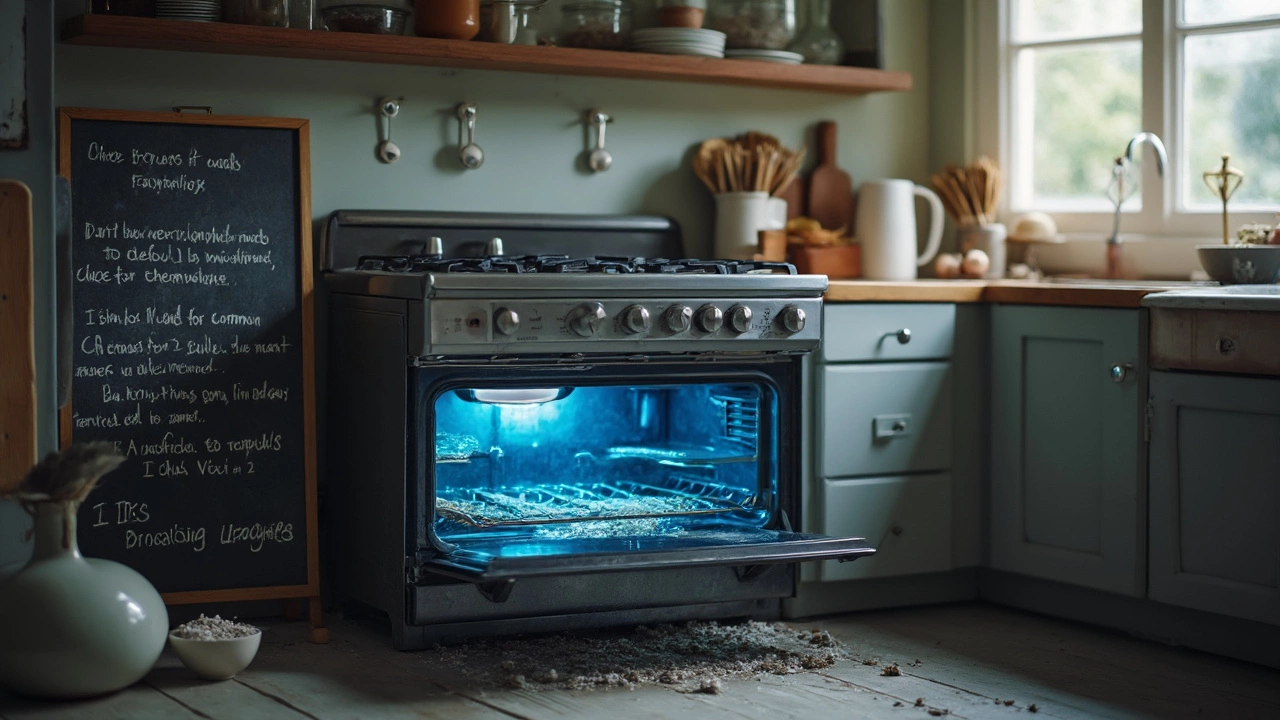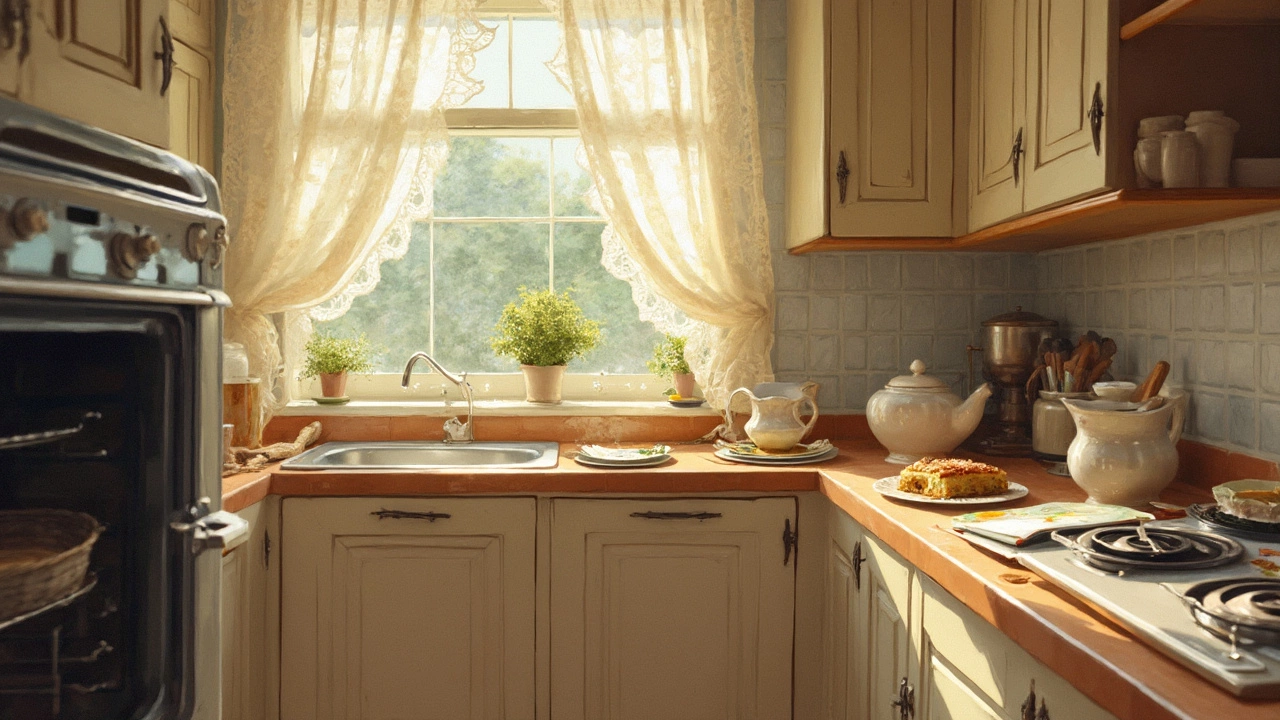So, your oven's heating element is on the fritz, and you're probably wondering what to do next. Can you just ignore it and keep on baking your favorite cookies, or is that going to turn your kitchen into a smoke-filled disaster zone?
First off, let's get something straight: the heating element is that coil or strip at the bottom of your oven. It’s like the heart of the whole operation, cranking up the heat when you need it. Now, when it's busted, you're going to run into heating issues.
Yeah, technically, you might still cook a thing or two if the broil element on top is functioning, but that's not exactly ideal for your cake-baking ambitions. Plus, even if you could make it work, you gotta think about safety and how efficiently your oven will run.
- How Heating Elements Work
- Identifying a Broken Heating Element
- Can You Cook with a Broken Element?
- Safety Concerns and Workarounds
- When to Call a Professional
How Heating Elements Work
Alright, let’s dive into the nitty-gritty of how your oven's heating element does its thing. It's basically like the sun of your kitchen universe — without it, everything would be pretty cold. The heating element is either a metal coil or a surface you see glowing orange when your oven is cranked up.
The job of a heating element is pretty straightforward. It uses electrical resistance to convert electricity into heat. So, when you turn on your oven, electricity flows through the element, creating heat due to resistance, much like those old-timey electric stoves with glowing coils.
“In a typical electric oven, the heating element is made of a wire that provides two to four kilowatts of power, subject to the oven’s design,” says Laura Anderson, a renowned appliance engineer.
Now, the heat doesn’t just hang out at the bottom. It gets distributed around the oven by convection, especially if you've got a fan-assisted model. This helps in cooking your food evenly.
There’s no need for rocket science here, but understanding these basics can help diagnose what’s gone wrong and decide what's next. If your element isn’t working, your oven could turn into a pricey storage box. Still, it doesn't mean it's doomed.
And here's a fun fact: Did you know that a typical oven heating element can get as hot as 900°F (or about 480°C)? Now that's some serious heat!
Identifying a Broken Heating Element
Alright, now let's figure out if your oven's heating element is actually broken, or if it's just throwing a tantrum. Spotting a busted heating element can save you from unnecessary repair costs and help you decide your next move.
The most obvious clue? Look for visible damage. Take a peek inside your oven; a broken element is often discolored or has exposed wires. Sometimes it even looks blistered or burnt. Trust your eyes on this one.
But say there's no clear damage. Does the oven take forever to heat up, or does it just refuse to get hot enough? That's a sign of a faulty heating element often messing with your baking plans. Another telltale is if only one part of your food cooks properly while the rest seems raw. That's not your cooking skills at fault; that's your oven's element acting up.
Got a multimeter handy? You can use it to test the element for continuity. No continuity means the element is kaput. If you're wondering what numbers to watch for, continuity is all about that needle moving. If it's stuck, you’ve got trouble.
Here's a quick and dirty check: turn on the oven and watch for the element to glow red. If it's not heating up evenly or flickers like a misbehaving holiday light, it's time to roll up the sleeves or call in some help.
- Visual inspection: Look for discoloration or damage.
- Performance issues: Slow preheat or uneven cooking.
- Continuity test: Use a multimeter for a definitive check.
Being able to identify these signs early can help you manage minor issues before they escalate into a major oven breakdown. So, wear your detective hat and get up close and personal with that oven!

Can You Cook with a Broken Element?
Alright, so your oven’s heating element just bit the dust, and you're standing there thinking about dinner. Can you still use the darn thing? Well, you might be able to, but it depends—and it’s not without a few hiccups.
First things first, if your lower heating element is broken, your oven might not heat evenly. Imagine trying to bake your favorite cookies and ending up with raw dough on one side and burnt spots on the other. Not the best outcome for your weekend baking spree!
If the top broil element is still working, you can potentially use it for oven tasks like broiling or even baking if you're in a pinch. But remember, it's going to be a game of experimenting—think more along the lines of watching a hawk-like precision to ensure things don’t burn.
You could try flipping whatever you’re baking halfway through to get a more even bake or putting it on a different rack. But honestly, this approach is really more of a patch than a solution. It's crucial to keep an eye on whatever you're cooking to avoid both undercooking and overcooking.
Besides, the safety aspect is something you can't ignore. A malfunctioning electric oven could be unpredictable. You certainly don't want any electrical issues rearing their ugly heads while you're just trying to enjoy a homemade pizza night.
In short, while you might muddle through with some limited oven use, it’s more of a temporary workaround than a lasting solution. Getting that heating element repaired is your best bet for consistent, safe results when you cook.
Safety Concerns and Workarounds
Now, using your oven with a broken heating element might sound tempting, especially when you're just trying to get dinner on the table. But, it's crucial to weigh the safety risks involved. A malfunctioning element can lead to uneven cooking. Worse, it might even cause electrical shorts or sparks due to exposed wiring, which is not something you want in your kitchen.
If you absolutely must use your oven, here are a few workarounds, but remember, these are temporary fixes:
- Switch to Broil: Most electric ovens have two heating elements, one on top for broiling. You can switch to broil for certain foods, but understand it's more intense and not ideal for everything.
- Use External Thermometers: An oven thermometer can help you gauge how much heat you're really getting. This keeps you in the loop even if your oven's temperature gauge is acting wonky.
- Utilize Smaller Appliances: Got a toaster oven or an air fryer? These can step in for smaller meals while you sort out the big guy.
Make sure to keep an eye on things when you're operating with workarounds, because you don't want any surprises like overheating. If you're trying to cook something that requires precision, you might end up more frustrated than full.
If your oven is making weird noises or the busted element looks like it’s deteriorating, stop using it immediately. Safety first, okay? When in doubt, call in a pro to give your adventurous repair efforts the green light.

When to Call a Professional
Deciding to get professional help with your broken oven is not an overreaction—it's often the wisest move when you’re dealing with electrical stuff. You don’t wanna play around with wires and amps unless you know exactly what you’re doing.
Here’s when you should really think about dialing up a professional: if the heating element isn't just broken but is also showing signs of burning or sparking when you try to use the oven. That’s not just inconvenient, it could be dangerous.
Another solid reason to bring in the pros is if you’ve already replaced the heating element and the oven still won't heat properly. There might be a deeper issue with the electrical wiring or control panel.
If your oven is making peculiar noises, or if there’s an unusual smell like something burning, turning it off and calling a specialist would be a smart move. Finally, if you notice any electrical problems while the oven is off, like flickering lights or tripping breakers, this could be indicative of a bigger electrical problem.
Many techs are equipped not only to fix electric ovens but also to spot potential future problems. Their expertise can save you time, money, and maybe even prevent a kitchen emergency.
| Signs To Call a Professional | Potential Risks |
|---|---|
| Sparking or Burning Element | Fire Hazard |
| Element Replacement Fails | Electrical Issues |
| Unusual Smells or Noises | Further Damage |
| Flickering Lights/Breaker Trips | Electrical System Faults |
So, yeah, when you see these red flags, calling in a pro isn't just a good idea—it could be absolutely necessary to keep your kitchen and home safe.


